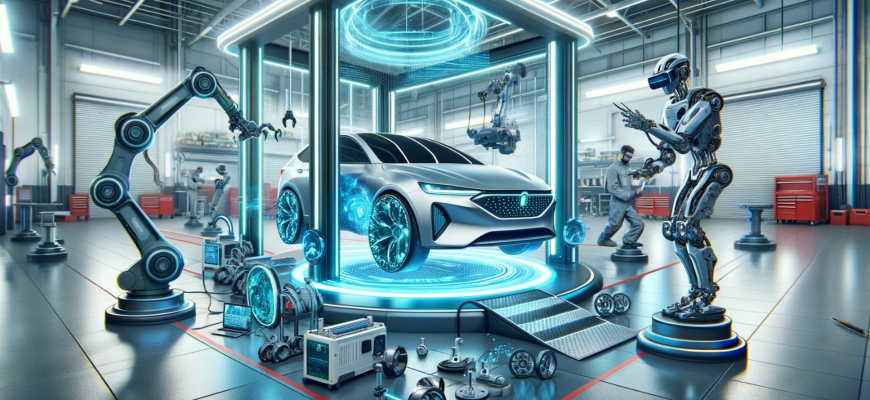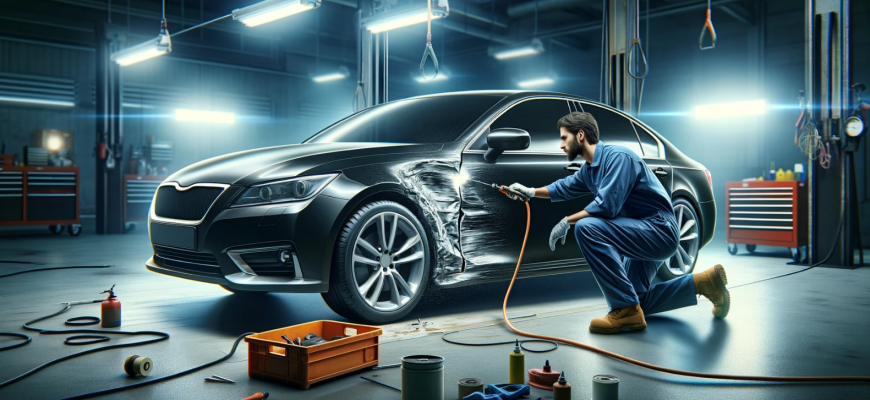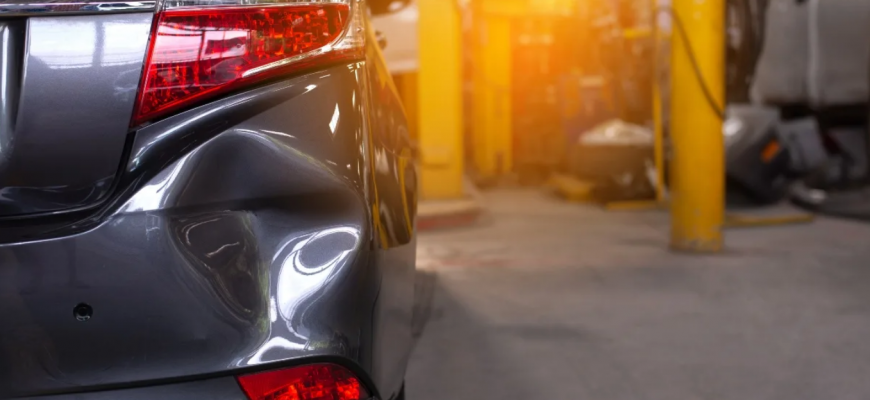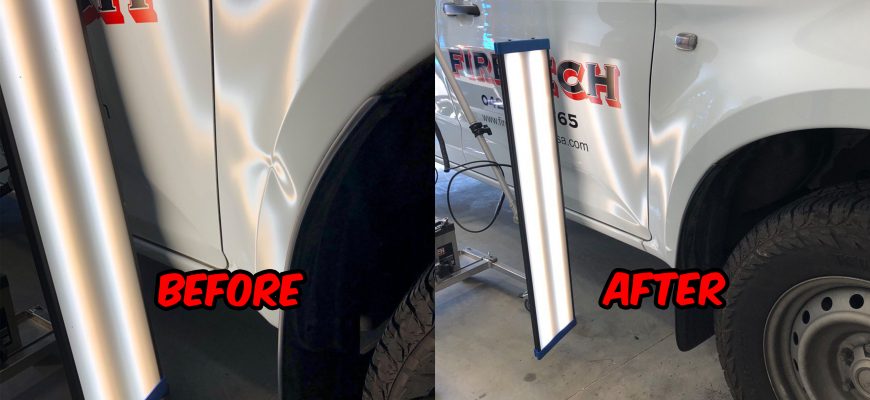The Latest Trends in Auto Body Repair Technologies: Navigating the Future of Automotive Care in Australia

The auto body repair industry is witnessing a remarkable transformation, fueled by technological advancements that promise to redefine the way we maintain and repair our vehicles. In Australia, where the automotive sector is a pivotal part of the economy and daily life, these innovations are not just enhancing operational efficiencies but are also significantly improving the consumer experience. This article delves into the latest trends in auto body repair technologies, highlighting how they benefit Australian vehicle owners.
Paintless Dent Removal (PDR) Techniques
Paintless Dent Removal (PDR) represents a significant leap forward from traditional dent repair methods. And it’s something we are particularly proud of at Dynamic Paint N Panel. This technique involves the meticulous manipulation of dents from behind the vehicle’s paneling, preserving the original paintwork. For consumers, the advantages are manifold: PDR offers a cost-effective solution to dent repairs, without the need for repainting, thereby maintaining the vehicle’s value and aesthetic appeal. Moreover, PDR can often be completed in a fraction of the time required for conventional repairs, providing a swift return to the road, and at a lower cost than conventional repairs.
Advanced Diagnostics and Robotics
The integration of advanced diagnostics and robotics in auto body repair is setting new standards for accuracy and efficiency. Sophisticated scanning tools can now detect minute damages invisible to the naked eye, ensuring comprehensive repair. Robotics, on the other hand, brings unmatched precision to the repair process, reducing the possibility of human error. For the Australian consumer, this translates to more accurate estimates, superior repair quality, and ultimately, enhanced safety and reliability of the repaired vehicle.
Augmented Reality (AR) in Repair Services
Augmented Reality (AR) is introducing a new dimension to auto body repair, from training technicians with virtual simulations to enhancing customer service. AR can project virtual images of repairs over the actual vehicle, helping consumers understand the work required and the parts involved. This technology fosters transparency and trust, empowering Australian consumers with knowledge and insight into their vehicle repairs.
Augmented Reailty is still largely untested and relies heavily on AI technology and training of specialist technicians – is this style of repair still decades away, or just around the corner?
The Impact of Insurance and Warranty Advances
Technological advancements are also streamlining the insurance claims and warranty process, offering faster and more efficient service. Digital platforms enable quicker submission of claims and documentation, reducing processing times and getting repairs started sooner. For Australians, this means less downtime without their vehicle and a smoother, more convenient claims experience.
Challenges and Considerations
Despite the promising advancements, challenges such as the need for skilled technicians and the initial cost of adopting new technologies persist. Additionally, ensuring equitable access to these advanced repair services across both urban and rural Australia remains a concern.
The landscape of auto body repair in Australia is evolving, driven by technological innovations that promise improved efficiency, sustainability, and customer satisfaction. As the industry continues to embrace these trends, Australian consumers stand to benefit from repairs that are quicker, more affordable, and of higher quality than ever before. Embracing these advancements is not just about keeping pace with technology but about moving forward into a future where auto care is more accessible, transparent, and aligned with the values of today’s society.
One thing that never changes is DPPs commitment to ensuring flawless repairs, and top notch customer service no matter what technology we have at our disposal. We started using traditional methods and have continued to evolve with advances in technology. To see how we can improve the of your car’s body work call us today. We love helping South Australian drivers beaming with pride over their car.
How to Fix a Car Dent: A Comprehensive Guide for South Australians

How to Fix a Car Dent: A Comprehensive Guide for South Australians
Car dents are more than just an eyesore; they can also decrease the value of your vehicle and, in some cases, affect its structural integrity. Whether it’s from a minor fender bender, hail damage, or a shopping cart mishap, understanding the process behind car dent repair is crucial for any car owner in Australia. This guide dives into the world of professional car dent repair, highlighting the expertise, tools, and considerations involved in making your vehicle look as good as new.
Understanding Car Dents
Car dents can vary significantly, from small dings to large indentations. The repair approach depends on several factors, including the dent’s size, location, and the vehicle’s body type. Understanding these differences is the first step in assessing repair options.
The Professional Dent Repair Process
Initial Assessment
A professional technician begins with a thorough assessment to understand the extent of the damage. This step is crucial as some dents may have underlying issues that aren’t immediately visible.
Repair Methodologies
Paintless Dent Removal (PDR): PDR is a popular repair method for small to medium-sized dents, where the paint surface is still intact. Technicians use special tools to gently massage the dent from behind the vehicle’s panel, restoring its original shape without needing to repaint the area.
Traditional Dent Repair: Larger dents or those where the paint has been compromised require a more invasive approach. This method involves sanding down the damaged area, applying a body filler, and repainting, which can be a time-consuming process.
Tools and Equipment
The tools for dent repair range from simple hand tools for PDR to sophisticated paint systems for matching the vehicle’s original color. 3D imaging technology is also becoming more prevalent for precise damage assessment.
The Expertise Behind Dent Repair
Dent repair is a skilled trade that requires significant training and experience. In Australia, technicians often undergo vocational training, such as a Certificate III in Automotive Body Repair Technology, complemented by years of on-the-job training. This expertise is crucial for effectively restoring a vehicle’s appearance and ensuring the repair lasts.
DIY vs. Professional Repair
While DIY kits are available, they often yield subpar results and can even worsen the damage. Professional repairs guarantee the use of the correct techniques and materials, ensuring a result that maintains your car’s value and appearance.
Choosing a Repair Service
When selecting a repair service, look for certified technicians with positive reviews and transparent warranty policies. Costs can vary based on the repair scope, but investing in quality repair is crucial for long-term satisfaction.
Maintenance Tips to Avoid Future Dents
Preventive measures can minimize the risk of dents. Parking away from other vehicles, using protective accessories like bumper guards, and maintaining a safe distance from potential hazards can help keep your car dent-free.
Car dent repair is a nuanced process that blends art and science. By understanding the types of dents, repair methodologies, and the importance of professional expertise, car owners can make informed decisions about their vehicle’s care. Always consult with a professional to assess and repair dents promptly, ensuring your car remains in pristine condition.
Remember, the appearance of your vehicle is not just about aesthetics; it’s also about maintaining its value and ensuring its longevity. Trusting professionals with the right training and tools for the job is the best way to achieve this.
The Hidden Risks of DIY Car Dent Removal: Why Professionals Do It Better

A dent on your car can be an eyesore and a reminder of an unfortunate incident. In Australia, where cars are not just a mode of transport but often a reflection of one’s lifestyle, keeping them in pristine condition is a priority for many. Among the myriad DIY fixes touted online, using a plunger to remove car dents stands out for its simplicity and the allure of a quick fix. However, the real question remains: Is it a viable long-term solution, or does it mask deeper issues?
Understanding the Plunger Method
The principle behind the plunger method is straightforward: by creating a vacuum, the plunger can pull the dented metal back into place. This method is often recommended for small to medium-sized dents where the paint has not been cracked or chipped. The steps involve moistening the plunger and the dent area to create a better seal, then using firm, consistent pressure to pop the dent back out – but there is a catch. It appears to only “work” (sometimes) on plastic parts of the car’s body work.
Hazards of DIY Car Dent Removal
The simplicity of the plunger method belies the potential risks involved in DIY dent removal. Applying uneven pressure or using the technique on unsuitable dents can exacerbate the damage, affecting the paint and underlying metal. Moreover, without the proper assessment, what appears as a minor dent could be indicative of more significant structural damage, a fact that DIY methods can easily overlook.
The Professional Alternative: Paintless Dent Removal (PDR)
Paintless Dent Removal (PDR) is a professional repair process that involves specialized tools and techniques to remove dents without affecting the vehicle’s factory paint job. Unlike DIY methods, PDR is performed by trained technicians who can assess the damage accurately and determine the most effective repair strategy. This method not only ensures the integrity of the repair but also maintains the vehicle’s resale value.
Why Trust Professionals Over DIY?
Professionals bring years of training and experience, coupled with an understanding of the nuances of automotive bodywork. They use specialized tools designed to access and repair dents from behind the vehicle’s paneling, ensuring a repair that’s both effective and invisible. The risk of additional damage is minimized, and many professionals offer warranties on their work, something DIY repairs cannot match.
Cost-Benefit Analysis: DIY vs. Professional Dent Removal
While the initial cost of a DIY fix might seem lower, the potential for inadvertently increasing the damage can lead to more substantial repair bills down the line. Professional PDR, on the other hand, while seemingly more expensive upfront, can prevent further issues and help maintain the car’s value over time. It’s a classic case of spending a little now to save a lot later.
Conclusion
While the allure of a quick and easy DIY fix for car dents is understandable, the potential risks and downsides cannot be ignored. Professional paintless dent removal offers a safer, more reliable solution that preserves both the vehicle’s appearance and its value. By choosing a professional repair, car owners can ensure their vehicle receives the care it deserves, safeguarding their investment for the future.
The Art of Paintless Dent Repair
Preserving Perfection: The Art of Paintless Dent Repair (PDR)
When it comes to restoring your vehicle’s former glory after a dent, the method you choose can significantly impact its overall appearance and value. One technique stands out above the rest for its ability to retain the factory paint finish, ensuring your car maintains its original color and texture. Enter Paintless Dent Repair (PDR) – a revolutionary approach that sets itself apart from traditional methods.
The PDR Advantage: A Symphony of Preservation
Retaining Factory Paint Finish
The most remarkable feature of PDR lies in the fact that it will keep the vehicle’s factory paint finish untouched. Unlike conventional dent repair approaches that often necessitate repainting, PDR eliminates this step entirely. This means your car’s original coat of paint remains as pristine as the day it rolled off the assembly line.
Disruption-Free Repairs
Traditional dent repair methods involve sanding, filling, and repainting, disrupting the car’s original paint in the process. PDR, on the other hand, is a non-invasive technique. It doesn’t disturb the paint in any way, ensuring that the integrity of the original finish is maintained. No more worrying about color mismatches or uneven textures – PDR preserves the aesthetics of your vehicle seamlessly.
The Seamless Blend: Where Art Meets Science
Eliminating Colour Mismatches
One of the most common concerns with traditional repairs is the risk of colour discrepancies. PDR eliminates this worry entirely. By keeping the original paint intact, there are no variations in colour between the repaired area and the rest of the vehicle. The result? A flawless, seamless blend that leaves no evidence of the dent.
Texture Harmony
Texture variations can be a telltale sign of a repair job. With PDR, the texture of the repaired area seamlessly integrates with the surrounding surfaces. Say goodbye to visible blending lines or awkward textures – PDR ensures that your vehicle’s exterior maintains its uniform, factory-like finish.
Preservation Beyond Aesthetics: The Practical Side of PDR
Beyond the visual appeal, PDR offers practical advantages. The process is typically quicker than traditional methods, meaning less time without your vehicle. Additionally, PDR can be more cost-effective since it eliminates the need for extensive repainting and material costs associated with traditional repairs.
Choosing Excellence for Your Vehicle
In the world of dent repair, preserving the original beauty of your vehicle is paramount. Paintless Dent Repair emerges as the champion, offering a solution that goes beyond fixing dents – it preserves the essence of your car. From maintaining the factory paint finish to ensuring a seamless blend, PDR is a testament to the marriage of art and science in automotive restoration. Choose PDR for a repair that not only fixes dents but leaves your vehicle looking as though it never had one.
Bringing Our Paintless Dent Removal Service to Adelaide

At DPP we know how frustrating those little shopping trolley dings and dents can be. They happen so quickly and easily and every time you look at your car your eye gets pulled towards that little dent. Fixing these little dents used to be a time-consuming, and sometimes expensive endeavour – but not anymore. Dynamic Paint N Panel is proud to bring our very own Paintless Dent Removal system to Adelaide.
Understanding Paintless Dent Removal:
Paintless Dent Removal is a specialised technique used to repair minor dents and dings on a vehicle’s body without the need for traditional bodywork and repainting. Unlike conventional methods, which often involve sanding, filling, and repainting, PDR preserves the original factory finish of the vehicle, making it a preferred choice for those who want a showroom finish without having to spend a packet.
How Paintless Dent Removal Works:
- Assessment and Access: Our Trained PDR technicians begin by assessing the dent’s size, location, and accessibility. This step determines whether PDR is suitable for the specific dent. Accessibility to the backside of the dent is essential for the technique to work effectively.
- Tools and Techniques: PDR utilises an array of specialised tools designed for precision. Technicians gently massage the dent from the backside, applying controlled pressure to reshape the metal gradually. This technique requires skill and finesse to avoid overcorrection or damage to the surrounding area.
- Light and Visual Inspection: A reflective light source or light board is used to visualize the damaged area’s contours and shadows. This technique helps technicians accurately plan their approach and monitor progress throughout the repair process.
- Gradual Restoration: The dent is meticulously massaged back to its original shape through a series of careful adjustments and manipulations. The goal is to achieve a seamless, smooth surface that blends seamlessly with the rest of the car’s body.
Benefits of Paintless Dent Removal:
- Preservation of Original Finish: PDR is a game-changer in the automotive repair industry due to its ability to maintain the car’s original paint finish. This preservation is essential for maintaining the vehicle’s aesthetic appeal and value.
- Cost-Effective: Traditional dent repair methods often involve extensive labour and repainting costs. PDR is a cost-effective alternative, as it requires fewer materials and reduces labour time, making it more budget-friendly for car owners.
- Time Efficiency: PDR is notably quicker than conventional methods, with many repairs taking only a few hours to complete. This convenience minimises the disruption to your daily routine and gets the vehicle back on the road sooner. In many cases we can come to you and fix the dent at your home or office.
- Environmentally Friendly: PDR generates minimal waste compared to traditional repairs that involve sanding, filling, and repainting. This eco-friendly aspect contributes to a greener automotive industry.
- Retained Resale Value: Vehicles with a history of PDR tend to retain their resale value better, as the original finish remains intact. Potential buyers are more likely to be attracted to a car that hasn’t undergone extensive repainting.
Paintless Dent Removal is more than a mere repair technique; it’s a testament to the innovation and progress in the automotive industry. With its intricate mechanics and impressive benefits, PDR has become a preferred choice for car owners seeking efficient, cost-effective, and eco-friendly dent repair solutions. This technique not only restores the vehicle’s aesthetics but also reflects a commitment to preserving both the vehicle’s beauty and its long-term value.
Don’t let those dents steal your car’s shine. Embrace the power of PDR and experience a cost-effective, time-efficient solution that maintains your car’s aesthetics and resale value. Contact our DPP today to transform your car back to its showroom glory! Say goodbye to dents and hello to a stunning ride. Get a free assessment now!
PDR is perfect for small dents where the paintwork hasn’t been damaged
- Cricket ball dent
- Football dents
- Shopping trolley dents
- Door dents
- Any dents that haven’t scratched/damaged the original paintwork.

